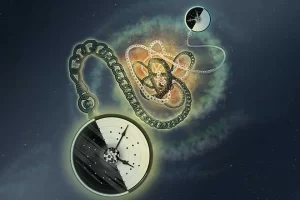Quantum clock features, advantages, disadvantages, How Quantum Clocks Work
A quantum clock is an ultra-precise timekeeping device that uses quantum mechanics to measure time with unparalleled accuracy. It is an advancement over traditional atomic clocks, utilizing optical transitions in atoms or ions to achieve higher precision. They can improve GPS positioning to centimeter-level accuracy.
What is a Quantum clock?
A quantum clock is a highly precise timekeeping device that leverages quantum mechanics to measure time with extreme accuracy. These clocks rely on the properties of quantum systems, such as atomic vibrations or optical transitions, to track time with far greater precision than conventional clocks.
Quantum clocks rely on the oscillations of atoms or ions when they absorb or emit energy. These oscillations act like an ultra-stable pendulum for measuring time. Unlike traditional atomic clocks, which use microwave frequencies, quantum clocks use optical frequencies, oscillating much faster and allowing for finer time measurement.
Quantum clocks improve GPS accuracy to the centimeter level. They help in fundamental physics research, such as testing Einstein’s relativity. They could be used in deep-space navigation and gravitational wave detection.
Quantum clocks have a precision of up to 1 second in 30 billion years. They can help test relativity, detect dark matter, and study quantum mechanics. They also detect gravitational variations to predict earthquakes and map underground.
How Quantum Clocks Work
Quantum clocks are often based on atomic clocks, but they use advanced quantum principles like:
- Quantum states allow for more precise frequency measurements.
- Optical Lattice Clocks – These use lasers to trap atoms in a grid-like pattern and measure their oscillations at optical frequencies.
- Strontium or Ytterbium Atoms – These elements are commonly used because their atomic transitions are highly stable.
Types of Quantum Clocks
Optical atomic clocks: Operate at optical frequencies (~quadrillion cycles per second), making them 100x more accurate than traditional microwave atomic clocks. They use neutral atoms (e.g., strontium, ytterbium) trapped in laser-generated optical lattices. They achieve extreme stability by preventing atoms from moving during measurement.
Nuclear Clocks (Theoretical): Would use nuclear energy levels instead of atomic transitions, potentially making them the most accurate timekeepers ever.
Optical Lattice Clocks: use neutral atoms (e.g., strontium, ytterbium) trapped in laser-generated optical lattices. They achieve extreme stability by preventing atoms from moving during measurement.
Ion Trap Clocks: Use single ions (e.g., aluminum ion) confined in electromagnetic fields. They are extremely precise but slower in measuring time due to single-ion limitations.
Quantum-Logic Clocks: Utilize quantum computing techniques to enhance time measurement. Example: A clock using aluminum ions but measured using magnesium ions.
Quantum clock features
Quantum clocks have several advanced features that set them apart from traditional atomic clocks.
- Unparalleled Precision: Quantum clocks can measure time with an accuracy of one second in billions of years (e.g., optical lattice clocks). They are thousands of times more precise than traditional cesium atomic clocks.
- Use of Quantum Transitions: Quantum clocks rely on quantum mechanical transitions in atoms (e.g., strontium, ytterbium, aluminum ions) rather than microwave transitions used in cesium atomic clocks. Optical transitions (light-based) allow for much higher frequency oscillations, improving time resolution.
- Optical Lattice & Ion Trap Technologies: Some quantum clocks use optical lattice structures to hold atoms in place using laser beams, minimizing atomic movement and improving stability. Others use ion traps, which confine single ions in electromagnetic fields for ultra-precise timekeeping.
- Stability & Low Drift: Quantum clocks exhibit extremely low-frequency drift, meaning they keep accurate time over incredibly long periods. They remain stable even under small variations in environmental conditions.
- Sensitivity to Gravitational Time Dilation: Quantum clocks are so precise that they can detect gravitational time dilation—showing time runs slightly faster at higher altitudes due to relativity. This makes them useful for geophysics, fundamental physics research, and even detecting underground structures.
- Advanced Laser Systems: Quantum clocks use ultra-stable lasers to probe atomic transitions with high precision. Frequency combs help measure optical frequencies accurately.
- Applications in Navigation & Communication: They can significantly improve GPS accuracy, reducing errors to the centimeter level. They are used in deep-space navigation, scientific research, and secure communication networks.
Quantum clock advantages
Quantum clocks are highly advanced timekeeping devices that leverage quantum mechanics to achieve unprecedented precision. Quantum clocks, especially optical lattice clocks, are far more precise than traditional atomic clocks, losing only about 1 second over the age of the universe (~13.8 billion years).
Quantum clocks are setting new benchmarks for international timekeeping, which can improve synchronization in global communications and financial markets. Their accuracy supports fundamental physics research, including tests of relativity, variations in fundamental constants, and dark matter studies.
Quantum clocks can measure tiny changes in gravity, helping in geodesy, underground resource detection, and early earthquake warnings. More precise timekeeping can significantly enhance GPS accuracy, reducing errors from nanoseconds to picoseconds, and improving global positioning systems.
Disadvantages of Quantum Clocks
High Cost & Complexity – Quantum clocks require sophisticated technology, ultra-cold temperatures, and specialized equipment, making them expensive and difficult to build. They require advanced laser and cooling systems.
Size & Practicality – While research is progressing, many quantum clocks are still bulky and impractical for commercial or portable use.
Fragility & Environmental Sensitivity – They require ultra-stable conditions and are highly sensitive to external disturbances like temperature fluctuations and electromagnetic interference.
Difficult Maintenance – Quantum clocks need precise calibration and maintenance, requiring highly trained specialists.
Limited Commercial Deployment – Despite their advantages, they are not yet widely available or integrated into mainstream systems due to their technical demands.
Quantum clocks are a revolutionary step in timekeeping, but their current limitations mean they are mostly used in research and specialized applications rather than everyday use. They are mainly used for scientific and space research rather than everyday applications.
You can follow Science Online on Youtube from this link: Science online
What are the importance of atomic clocks and How do Atomic Clocks work?
What are the advantages and disadvantages of using the Internet?
Global Positioning System (GPS Tracking System) advantages and disadvantages
Global Navigation Satellite System (GNSS) types, use & importance
What are the importance and uses of Satellites in our life?
Idea of launching the satellite & Factors affecting the orbital velocity of a satellite
Extranet review, features, use, advantages and disadvantages
Intranet advantages, disadvantages, How do Intranet, Internet, and Extranet differ?
Benefits & application of Artificial intelligence in business, E-commerce and marketing
Online marketing uses, advantages and disadvantages
What are the advantages and disadvantages of Internet banking?




